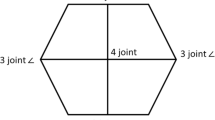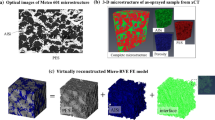Abstract
An integrated thermal, microstructure, and thermomechanical model was developed to predict temperature, thermomechanical strain, stress and distortion evolution during laser cladding of engine blade repair. The model was used to analyze a simplified geometry to evaluate the effect of process conditions on solidification cracking tendency. Two cases with and without cooling to room temperature between welded layers were studied. Simulation results suggested that laser cladding without cooling down between welded layers produces higher temperature, higher thermomechanical tensile strain during cooling after solidification than with cooling down between welded layers. This indicates that the solidification cracking tendency is higher without cooling down between welded layers than with cooling down between welded layers. Because of the preheating effect resulted from the continual laser cladding without cooling down between welded layers, the residual stress is lower, but the distortion is higher than the case with cooling down between welded layers.
Similar content being viewed by others
References
Park J.W., Vitek J.M., Babu S.S., David S.A.: Stray grain formation, thermomechanical stress and solidification cracking in single crystal nickel base superalloy welds, Science and Technology of Welding and Joining, 2004, vol. 9, no. 6, pp. 472–482.
Xie Y, Wang M., Zhang G., Chang M.: Analysis of superalloy turbine blade tip cracking during service, Engineering Failure Analysis, 2006, vol. 13, no. 8, pp. 1429–1436.
Griffith M.L., Ensz M.T., Puskar J.D., Robino C.V., Brooks J.A., Philliber J.A., Smugeresky J.E., Hofmeister W.H.: Understanding the microstructure and properties of components fabricated by laser engineered net shaping (LENS), Materials Research Society Symposium Proceedings, 2000, vol. 625, pp. 9–20.
Griffith M.L., Schlienger E., Harwell L.D., Oliver M.S., Baldwin M.D., Ensz M.T., Essien M., Brooks J., Robino C.V., Smugeresky J.E., Hofmeister W.H., Wert M.J., Nelson D.V.: Understanding thermal behavior in the LENS process, Materials and Design, June 1999, vol. 20, no. 2/3, pp. 107–113.
Hofmeister W.H., Griffith M.L., Ensz M.T., Smugeresky J.E.: Solidification in direct metal deposition by LENS processing, JOM, 2001, vol. 53, no. 9, pp. 30–34.
Hofmeister W.H., Wert M.J., Smugeresky J.E., Philliber J.A., Griffith M.L., Ensz M.T.: Investigating solidification with the laser-engineered net shaping (LENS™) process”, JOM, 1999, vol. 51, no. 7, http://www.tms.org/pubs/journals/jom/9907/hofmeister/hofmeister-9907.html
Kelly S.M., Kampe S.L.: Microstructural evolution in laser-deposited multilayer Ti-6AI-4V builds: Part I. Microstructural characterization, Metallurgical and Materials Transactions A, 2004, vol. 35, no. 6, pp. 1861–1867.
Kelly S.M., Kampe S.L.: Microstructural evolution in laser-deposited multilayer Ti-6AI-4V builds: Part II. Thermal modeling, Metallurgical and Materials Transactions A, 2004, vol. 35, no. 6, pp. 1869–1879.
Ghosh S., Choi J.: Deposition pattern based thermal stresses in single-layer laser aided direct material deposition process, Journal of Manufacturing Science and Engineering, 2007, vol. 129, no. 2, pp. 319–332.
Yin H., Wang L, Felicelli S.D.: Comparison of two-dimensional and three-dimensional thermal models of the LENS® process, Journal of Heat Transfer, 2008, vol. 130, no. 10, pp. 1–7.
Special Metals, http://www.specialmetals.com/documents/lnconel%20alloy%20625.pdf/documents/lnconel%20alloy%20625.pdf.
Goldak J., Chakravarti A., Bibby M.: A new finite element model for welding heat sources, Metallurgical Transactions, June 1984, vol. 15B, no. 2, pp. 299–305.
Yang Y.R, Dong P., Zhang J.: A hot-cracking mitigation technique for welding high-strength aluminum alloy, Welding Journal, 2000, vol. 79, no. 1, pp. 9–s–17–s.
Yang Y.R, Babu S., Vaze S., Kikel J., Dewees D.: Crack mitigation during buttering and cladding of a low alloy steel pipe, Proceedings of the 8th International Conference on Trends in Welding Research, Pine Mountain, Georgia, June 2–6, 2008.
Guo Z., Saunders N., Schule J.R, Miodownik A.R: Material properties for process simulation, Materials Science and Engineering A, 2009, vol. 499, no. 1–2, pp. 7–13.
Author information
Authors and Affiliations
Rights and permissions
About this article
Cite this article
Yang, YP., Babu, S.S. An Integrated Model to Simulate Laser Cladding Manufacturing Process for Engine Repair Applications. Weld World 54, R298–R307 (2010). https://doi.org/10.1007/BF03266743
Published:
Issue Date:
DOI: https://doi.org/10.1007/BF03266743




